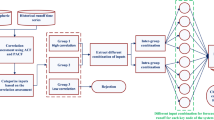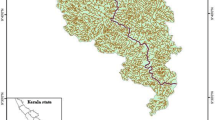Abstract
Reservoir inflow forecasts are important for guiding reservoir operation. This study proposes an integrated framework of incorporating different forms of seasonal inflow forecasts in identifying the optimal releases policy. Gridded precipitation forecasts from climate models have been widely used for forecasting inflow. Both precipitation forecasts and soil moisture estimates are used as predictors to provide one-season-ahead reservoir inflow forecasts by constructing a regression problem. Principal component analysis is used to reduce the dimension of the regression problem, and a Bayesian regression technique is employed to generate various forms of inflow forecasts such as deterministic, probabilistic and ensemble forecasts. Two optimization models are constructed to couple with different forms of inflow forecasts. The first model aims to maximize hydropower generation and the second one aims to minimize end-of-season reservoir storage deviation from the target storage. Both single-value inflow and ensemble forecasts are incorporated to find the optimal water releasing policy considering inflow uncertainty and end-of-season reservoir storage requirement. The proposed methodology is demonstrated for Huangcai Reservoir in southern China. Bayesian regression technique shows good performance of seasonal inflow forecasts with a Pearson correlation of 0.8 and rank probability score of 0.4, which outperforms climatology. The coupling of ensemble inflow forecasts and optimization models provides water managers a set of release policies considering inflow uncertainty.








Similar content being viewed by others
References
Anghileri D, Voisin N, Castelletti A, Pianosi F, Nijssen B, Lettenmaier DP (2016) Value of long-term streamflow forecasts to reservoir operations for water supply in snow-dominated river catchments. Water Resour Res 52(6):4209–4225
Arsenault R, Latraverse M, Duchesne T (2016) Water Resour Manag 30:4363. https://doi.org/10.1007/s11269-016-1425-4
Arsenault R, Latraverse M, Duchesne T (2016) An Efficient Method to Correct Under-Dispersion in Ensemble Streamflow Prediction of Inflow Volumes for Reservoir Optimization. Water Resour Manag 30(12): 4363-4380. https://doi.org/10.1007/s11269-016-1425-4
Bartolini P, Salas JD (1993) Modeling of streamflow processes at different time scales. Water Resour Res 29(8):2573–2587
Block PJ, Souza Filho FA, Sun L, Kwon HH (2009) A streamflow forecasting framework using multiple climate and hydrological models 1. JAWRA J Am Water Resour Assoc 45(4):828–843
Bowman AW, Azzalini A (1997) Applied smoothing techniques for data analysis: the kernel approach with S-plus illustrations. Oxford University Press, New York
Chen L, Singh VP, Lu W, Zhang J, Zhou J, Guo S (2016) Streamflow forecast uncertainty evolution and its effect on real-time reservoir operation. J Hydrol. https://doi.org/10.1016/j.jhydrol.2016.06.015
D’Ambrosio C, Lodi A, Martello S (2010) Piecewise linear approximation of functions of two variables in MILP models. Oper Res Lett 38:39–47. https://doi.org/10.1016/j.orl.2009.09.005
Day GN (1985) Extended streamflow forecasting using NWSRFS. J Water Resour Plan Manag 111(2):157–170
Dumedah G, Coulibaly P (2013) Evolutionary assimilation of streamflow in distributed hydrologic modeling using in-situ soil moisture data. Adv Water Resour 53:231–241
Fan Y, Dool H (2004) Climate prediction center global monthly soil moisture data set at 0.5 resolution for 1948 to present. J Geophys Res Atmos 109(D10):D10102
Golembesky K, Sankarasubramanian A, Devineni N (2009) Improved drought management of falls Lake reservoir: role of multimodel streamflow forecasts in setting up restrictions. J Water Resour Plan Manag 135(3):188–197
Goor Q, Kelman R, Tilmant A (2011) Optimal multipurpose-multireservoir operation model with variable productivity of hydropower plants. J Water Resour Plan Manag. https://doi.org/10.1061/(ASCE)WR.1943-5452.0000117
Grantz K, Rajagopalan B, Clark M, Zagona E (2005) A technique for incorporating large-scale climate information in basin-scale ensemble streamflow forecasts. Water Resour Res 41(10):W10410
Hamlet AF, Lettenmaier DP (1999) Columbia River streamflow forecasting based on ENSO and PDO climate signals. J Water Resour Plan Manag 125(6):333–341
Hsu K, Gupta HV, Sorooshian S (1995) Artificial neural network modeling of the rainfall-runoff process. Water Resour Res 31(10):2517–2530
Huang J, van den Dool HM, Georgarakos KP (1996) Analysis of model-calculated soil moisture over the United States (1931–1993) and applications to long-range temperature forecasts. J Clim 9(6):1350–1362
Johnell A, Lindström G, Olsson J (2007) Deterministic evaluation of ensemble streamflow predictions in Sweden. Hydrol Res 38(4-5):441–450
Kalra A, Ahmad S (2009) Using oceanic-atmospheric oscillations for long lead time streamflow forecasting. Water Resour Res 45(3):W03413
Lettenmaier PD, Wood FE (1993) In: Maidment D (ed) Hydrological forecasting chapter 26 in handbook of hydrology. McGraw-Hill, New York
Li S, Goddard L (2005) Retrospective forecasts with ECHAM4.5 AGCM IRI. Technical report, 05-02 December. International Research Institute for Climate and Society, University of Columbia, New York
Lima CHR, Lall U (2010) Climate informed monthly streamflow forecasts for the Brazilian hydropower network using a periodic ridge regression model. J Hydrol 380(3-4):438–449
Loucks DP, Beek E, Stedinger JR, Dijkman JPM, Villars MT (2005) Water resources systems planning and management. Delft Hydraulics, The Netherland
Maurer EP, Lettenmaier DP (2004) Potential effects of long-lead hydrologic predictability on Missouri River main-stem reservoirs. J Clim 17(1):174–186
Moradkhani H, Meier M (2010) Long-lead water supply forecast using large-scale climate predictors and independent component analysis. J Hydrol Eng 15(10):744–762
Najafi MR, Moradkhani H, Piechota TC (2012) Ensemble streamflow prediction: climate signal weighting methods vs. climate forecast system reanalysis. J Hydrol 442:105–116
Nwaogazie IL (1987) Comparative analysis of some explicit-implicit streamflow models. Adv Water Resour 10(2):69–77
Piechota TC, Dracup JA (1999) Long-range streamflow forecasting using El Nino-southern oscillation indicators. J Hydrol Eng 4(2):144–151
Roeckner E, Arpe K, Bengtsson L, Christoph M, Claussen M, Dümenil L, Schulzweida U (1996) The atmospheric general circulation model ECHAM-4: model description and simulation of present-day climate. Report 218. Max-Planck-Institut für Meteorologie, Hamburg
Salas JD, Delleur JW, Yevjevich V, Lane WL (1980) Applied modeling of hydrologic time series. Water Resources Publication, Littleton
Sankarasubramanian A, Lall U, Espinueva S (2008) Role of retrospective forecasts of GCMs forced with persisted SST anomalies in operational streamflow forecasts development. J Hydrometeorol 9(2):212–227
Schwanenberg D, Fan FM, Naumann S et al (2015) Water Resour Manag 29:1635. https://doi.org/10.1007/s11269-014-0899-1
Steinschneider S, Brown C (2012) Dynamic reservoir management with real-option risk hedging as a robust adaptation to nonstationary climate. Water Resour Res 48(5):W05524
Schwanenberg D, Fan FM, Naumann S, Kuwajima JI, Montero RA, Reis AA (2015) Short-Term Reservoir Optimization for Flood Mitigation under Meteorological and Hydrological Forecast Uncertainty. Water Resour Manag 29(5): 1635-1651. https://doi.org/10.1007/s11269-014-0899-1
Vrugt JA, Ter Braak CJF, Clark MP, Hyman JM, Robinson BA (2008) Treatment of input uncertainty in hydrologic modeling: doing hydrology backward with Markov chain Monte Carlo simulation. Water Resour Res 44, W00B09, https://doi.org/10.1029/2007WR006720
Wang H, Arumugam S and Ranjithan RS (2011). Integration of Climate and Weather Information for Improving 15-Day-Ahead Accumulated Precipitation Forecasts. Journal of Hydrometeorology https://doi.org/10.1175/JHM-D-11-0128.1
Wang H, Reich B, Lim YH (2013) A Bayesian approach to probabilistic streamflow forecasts. J Hydroinf 15(2):381–391
Wei W, Watkins DW (2011) Probabilistic streamflow forecasts based on hydrologic persistence and large-scale climate signals in Central Texas. J Hydroinf 13(4):760–774
Werner K, Brandon D, Clark M, Gangopadhyay S (2004) Climate index weighting schemes for NWS ESP-based seasonal volume forecasts. J Hydrometeorol 5(6):1076–1090
Wood AW, Lettenmaier DP (2006) A test bed for new seasonal hydrologic forecasting approaches in the western United States. Bull Am Meteorol Soc 87(12):1699–1712
Wood AW, Schaake JC (2008) Correcting errors in streamflow forecast ensemble mean and spread. J Hydrometeorol 9(1):132–148
Xu K, Brown C, Kwon HH, Lall U, Zhang J, Hayashi S, Chen Z (2007) Climate teleconnections to Yangtze river seasonal streamflow at the three gorges dam, China. International Journal of Climatology: A Journal of the Royal Meteorological Society 27(6):771–780
Zealand CM, Burn DH, Simonovic SP (1999) Short term streamflow forecasting using artificial neural networks. J Hydrol 214(1-4):32–48
Zhao T, Cai X, Yang D (2011) Effect of streamflow forecast uncertainty on real-time reservoir operation. Adv Water Resour 34(4):495–504
Zhao Q, Cai X, Li Y (2019) Determining inflow forecast horizon for reservoir operation. Water Resour Res 55:4066–4081
Author information
Authors and Affiliations
Corresponding author
Ethics declarations
Conflict of Interest
None.
Additional information
Publisher’s Note
Springer Nature remains neutral with regard to jurisdictional claims in published maps and institutional affiliations.
Rights and permissions
About this article
Cite this article
Long, Y., Wang, H., Jiang, C. et al. Seasonal Inflow Forecasts Using Gridded Precipitation and Soil Moisture Information: Implications for Reservoir Operation. Water Resour Manage 33, 3743–3757 (2019). https://doi.org/10.1007/s11269-019-02330-8
Received:
Accepted:
Published:
Issue Date:
DOI: https://doi.org/10.1007/s11269-019-02330-8




